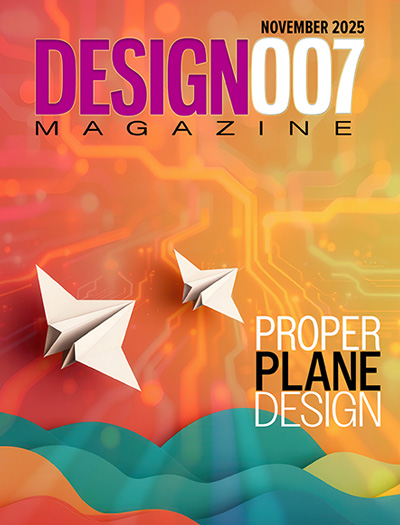-

-
News
News Highlights
- Books
Featured Books
- design007 Magazine
Latest Issues
Current Issue
Designing Proper Planes
Without planes, designers would have to create thousands of traces to accomplish the same objectives. Power planes provide low impedance and stable power, and ground planes stabilize reference voltage, improve thermal performance, and help preclude EMI issues.

Power Integrity
Current power demands are increasing, especially with AI, 5G, and EV chips. This month, our experts share “watt’s up” with power integrity, from planning and layout through measurement and manufacturing.

Signal Integrity
If you don’t have signal integrity problems now, you will eventually. This month, our expert contributors share a variety of SI techniques that can help designers avoid ground bounce, crosstalk, parasitic issues, and much more.
- Articles
- Columns
- Links
- Media kit
||| MENU - design007 Magazine
Just Ask Joe: Standardized Grid Designs
August 26, 2020 | I-Connect007 Research TeamEstimated reading time: 2 minutes
First, we asked you to send in your questions for Happy Holden. Now, it’s Joe Fjelstad’s turn! Inventor, columnist, instructor, and founder of Verdant Electronics, Joe has been involved with rigid PCBs and flexible circuits for decades, and he’s ready to share some of his knowledge with our readers. We hope you enjoy “Just Ask Joe.”
Q: Will standardized grid designs ever come to fruition?
A: I am old enough to know that once upon a time, the electronics industry actually had a standardized grid. It was 0.100”. It was the natural by-product of the fact that most early electronic packages were dual in-line packages (DIPs), and nearly all of the first DIPs had their leads on 100-mil pitch (the Soviets and Eastern Bloc nations went with 2.5 mm rather than 2.54 mm or 0.1 inches). It was a natural default, and 100-mil grid pitch design was common and the standard even today; think of hobbyist’s bread boards, which are on a 100-mil grid.
Those halcyon days were disrupted as pin counts rose, and surface-mount technology took the stage to help manage the explosion in package pin counts. Then there was the “80% rule” for package leads that took effect to provide a defined roadmap for following generation component lead pitch. Thus, today (ignoring inch-based devices), we have 2.5 mm, 2.0 mm, 1.5 mm, 1.25 mm, 1.0 mm, 0.8 mm, 0.65 mm, 0.5 mm, 0.4 mm, etc.
Area array technology offered the opportunity to return to a standard grid, but the 80% rule was applied instead, which is a great pity from my perspective. Instead, what might have been done is to agree on a common base grid pitch and depopulate to the pin count desired. Everything gets easier again—no more burning off layers of circuits to accommodate escapes and differing grid pitch components. It is an easy way to return to standardized grids. All that is necessary is for component packagers to offer every component with terminations on a standard grid. My suggestion is 0.5 mm because that is where component soldering yields start to fall off.
Is it possible to return to the standard grid? Absolutely. It is more a question of customer demand for such and package foundries’ willingness to do so. It could save billions of dollars annually, according to my back-of-the-napkin calculations.
To pose your own question for Joe Fjelstad, click here.
Joe Fjelstad is founder and CEO of Verdant Electronics and an international authority and innovator in the field of electronic interconnection and packaging technologies with more than 185 patents issued or pending. To read past "Flexible Thinking" columns or contact Fjelstad, click here. Download your free copy of Fjelstad’s book Flexible Circuit Technology, 4th Edition, and watch the micro webinar series on flexible circuit technology.
Testimonial
"Our marketing partnership with I-Connect007 is already delivering. Just a day after our press release went live, we received a direct inquiry about our updated products!"
Rachael Temple - AlltematedSuggested Items
Strong Signal for the Industry: productronica 2025 Drives Positive Industry Trend
11/21/2025 | productronicaFrom November 18 to 21, over 1,600 exhibitors from 52 countries met at productronica to present innovations in electronics development and production.
I-Connect007 Editor’s Choice: Five Must-Reads for the Week
11/21/2025 | Michelle Te, I-Connect007Were you one of the lucky ones who made it to Europe’s largest electronics trade show this week? By all accounts, this massive event was buzzing with new technologies, packed booths, and plenty of tired feet by the end of each day. So, if you’re heading home from productronica (or, like me, just enjoying the end of a busy week), now’s the perfect time to unwind a bit. Settle into that airplane seat (or office chair), grab a snack, and catch up on some great reads from I-Connect007.
Renewable Power: STMicroelectronics and TSE Sign 15-Year PPA to Power French Sites with Solar Energy
11/21/2025 | Globe NewswireTSE, a leading player in solar energy and agrivoltaics in France, and STMicroelectronics, a global semiconductor leader serving customers across the spectrum of electronics applications, have signed a physical Power Purchase Agreement (PPA) to supply renewable electricity from solar parks to STMicroelectronics’ sites in France.
2025 Charles Hutchins Educational Grant Winner Announced
11/20/2025 | SMTASMTA is honored to announce Abdelrahman Farrag, a Ph.D. candidate from State University of New York at Binghamton, has been selected as the winner of the 2025 Charles Hutchins Educational Grant.
Incap India Wins the Award for Excellence in New Product Development
11/20/2025 | IncapIncap India is pleased to announce that it has been honoured with the Award for Excellence in New Product Development from one of our big multinational customers.


